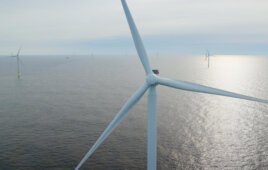This article comes from Pierce Atwood LLP and is authored by Thomas R. Doyle, John M. Formella and Matthew D. Manahan
The Maine Department of Environmental Protection has announced that it is developing a new Site Law rule that will address certain development standards for wind projects. The standards that will be addressed by the new rule are in the Wind Energy Act, but are not addressed in current DEP rules. To help facilitate the development of the new rule, DEP has released a pre-rulemaking draft for public comment.
As currently drafted, the new rule will apply to any grid scale wind energy development that is proposed for location within an expedited permitting area, and certain standards will also apply to small scale wind energy developments. Under the Maine Wind Energy Act, such developments must be reviewed for impacts related to scenic character, shadow flicker, public safety, tangible benefits, and decommissioning. The new rule will lay out the considerations DEP will use when reviewing a project under these standards. The draft rule will not address best practical mitigation measures, which will be the subject of a future rulemaking proposal.

As currently drafted, the new rule will apply to any grid scale wind energy development that is proposed for location within an expedited permitting area, and certain standards will also apply to small scale wind energy developments.
Under the new rule, when reviewing projects for impacts to scenic character, DEP will consider the following: (1) scenic impacts of a development’s associated facilities; (2) the level of significance of any potentially affected Scenic Resource of State or National Significance (SRSNS); (3) the existing character of the surrounding area; (4) the expectations of a typical viewer; (5) the purpose and context of the proposed wind energy development; (6) the extent of the public’s use and enjoyment of any affected SRSNS; (7) the scope and scale of any effect on a SRSNS; (8) the cumulative scenic impact or effect when combined with other wind energy developments located within eight miles of any affected SRSNS; and (9) whether there is any unreasonable adverse effect on scenic character.
Importantly, with respect to scenic impacts, the proposed rule would allow DEP to apply traditional Site Law standards to a proposed wind power project if DEP determines the project “may result in unreasonable adverse effects.”
With respect to shadow flicker, the new rule will require applicants to demonstrate that a proposed wind energy development has been designed to avoid unreasonable adverse shadow flicker effects at any occupied building located on property not owned by the applicant. This will require the submission of a shadow flicker analysis using WindPRO or other modeling software provided by DEP.
Applicants will need to demonstrate that proposed projects will maintain public safety through construction with adequate setbacks (the rule provides required minimums) and other considerations such as safety design standards and fire prevention measures.
The tangible benefits provisions will require applicants to show that a proposed development will establish environmental and economic improvements or benefits to the citizens of Maine that are attributable to the construction, operation, and maintenance of the proposed development.
Finally, the decommissioning provisions will require applicants to demonstrate adequate financial capacity to decommission the proposed development at any time during construction or operation of the development, or upon termination of development operations for any reason.
Click here to access a full copy of the pre-rulemaking draft. Written comments on the pre-rulemaking draft may be submitted to Mark Margerum and must be received no later than 5:00 p.m. on Monday, August 8, 2016.
Filed Under: News, Projects





